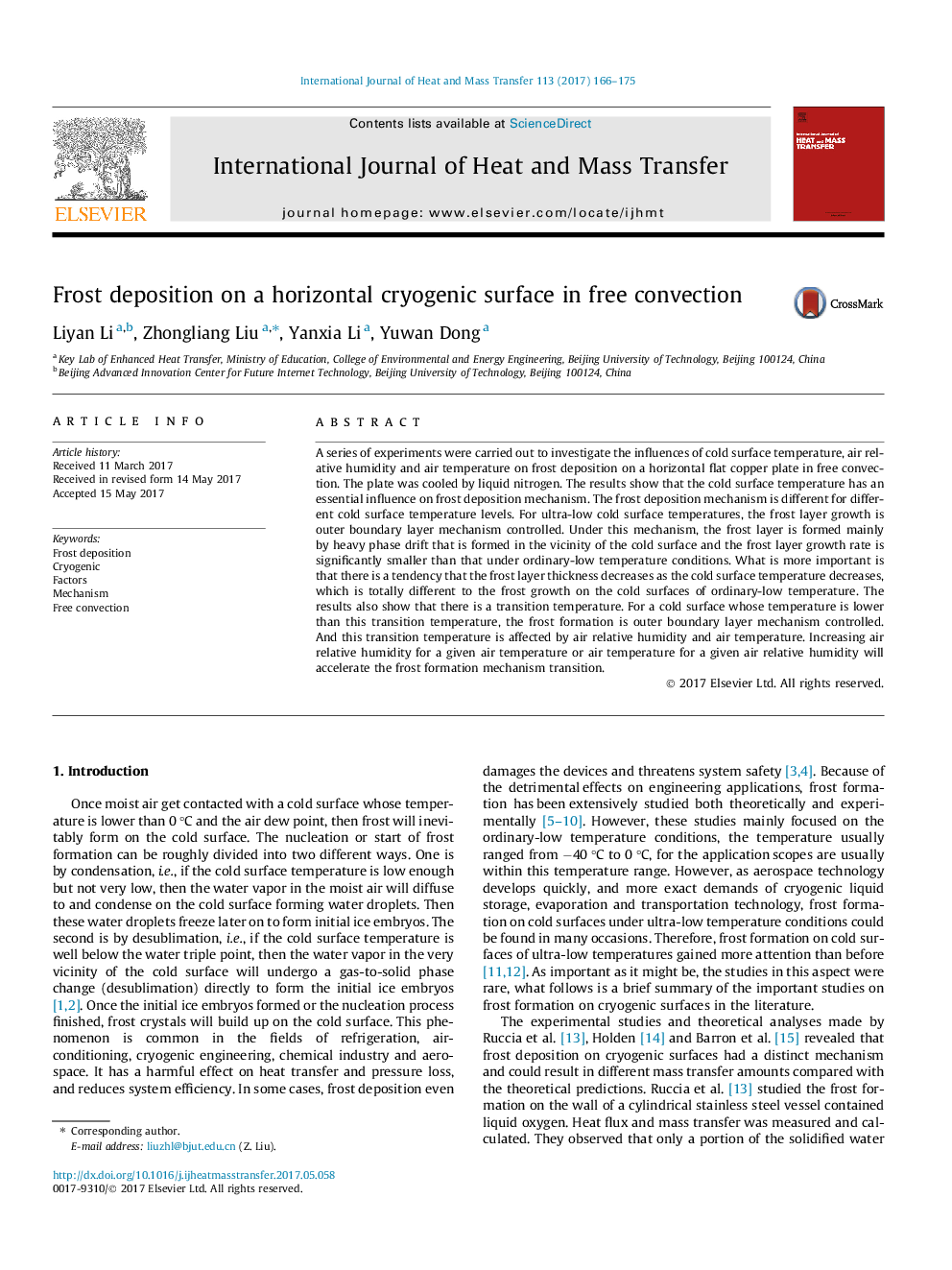| کد مقاله | کد نشریه | سال انتشار | مقاله انگلیسی | نسخه تمام متن |
|---|---|---|---|---|
| 4994164 | 1458028 | 2017 | 10 صفحه PDF | دانلود رایگان |
عنوان انگلیسی مقاله ISI
Frost deposition on a horizontal cryogenic surface in free convection
ترجمه فارسی عنوان
رسوب یخ زده روی سطح یخ زده ی افقی در محفظه ی آزاد
دانلود مقاله + سفارش ترجمه
دانلود مقاله ISI انگلیسی
رایگان برای ایرانیان
کلمات کلیدی
رسوبات یخ زده، فریزر عوامل، مکانیسم، کنجکاوی رایگان
ترجمه چکیده
یک سری از آزمایشات به منظور بررسی تأثیرات دمای سطح سرد، رطوبت نسبی هوا و دمای هوا بر روی رسوب یخ زدگی بر روی ورق مس مسطح مسطح انجام شده است. این صفحه با نیتروژن مایع سرد می شود. نتایج نشان می دهد که دمای سطح سرد تاثیر مؤثری بر مکانیزم رسوبدهی فراست دارد. مکانیزم انجماد فراست برای سطوح مختلف درجه حرارت سرد متفاوت است. برای دمای بسیار پایین دمای سرما، رشد لایه یخبندان مکانیسم لایه ی مرزی بیرونی کنترل می شود. تحت این مکانیزم، لایه یخبندان به طور عمده توسط ریزش فاز سنگین شکل می گیرد که در مجاورت سطح سرد شکل می گیرد و سرعت رشد یخ زدگی به طور قابل توجهی کوچکتر از دمای معمولی است. مهمتر این است که گمان می رود که ضخامت لایه یخبندان با کاهش دمای سطح سرد، کاملا متفاوت با رشد یخبندان در سطوح سرد دمای معمولی باشد. نتایج همچنین نشان می دهد که دمای انتقال وجود دارد. برای یک سطح سرد که دمای آن پایین تر از این دمای انتقال است، شکل گیری یخبندان مکانیسم لایه مرزی بیرونی کنترل شده است. و این دمای انتقال تحت تاثیر رطوبت نسبی هوا و دمای هوا قرار گرفته است. افزایش رطوبت نسبی هوا برای یک دمای هوا یا درجه حرارت هوا برای یک رطوبت نسبی هوا، انتقال مکانیزم تشکیل یخ زدگی را تسریع خواهد کرد.
موضوعات مرتبط
مهندسی و علوم پایه
مهندسی شیمی
جریان سیال و فرایندهای انتقال
چکیده انگلیسی
A series of experiments were carried out to investigate the influences of cold surface temperature, air relative humidity and air temperature on frost deposition on a horizontal flat copper plate in free convection. The plate was cooled by liquid nitrogen. The results show that the cold surface temperature has an essential influence on frost deposition mechanism. The frost deposition mechanism is different for different cold surface temperature levels. For ultra-low cold surface temperatures, the frost layer growth is outer boundary layer mechanism controlled. Under this mechanism, the frost layer is formed mainly by heavy phase drift that is formed in the vicinity of the cold surface and the frost layer growth rate is significantly smaller than that under ordinary-low temperature conditions. What is more important is that there is a tendency that the frost layer thickness decreases as the cold surface temperature decreases, which is totally different to the frost growth on the cold surfaces of ordinary-low temperature. The results also show that there is a transition temperature. For a cold surface whose temperature is lower than this transition temperature, the frost formation is outer boundary layer mechanism controlled. And this transition temperature is affected by air relative humidity and air temperature. Increasing air relative humidity for a given air temperature or air temperature for a given air relative humidity will accelerate the frost formation mechanism transition.
ناشر
Database: Elsevier - ScienceDirect (ساینس دایرکت)
Journal: International Journal of Heat and Mass Transfer - Volume 113, October 2017, Pages 166-175
Journal: International Journal of Heat and Mass Transfer - Volume 113, October 2017, Pages 166-175
نویسندگان
Liyan Li, Zhongliang Liu, Yanxia Li, Yuwan Dong,
